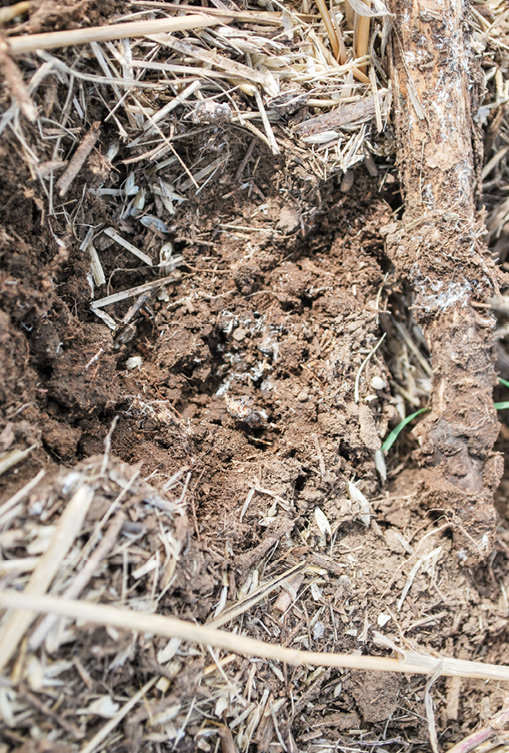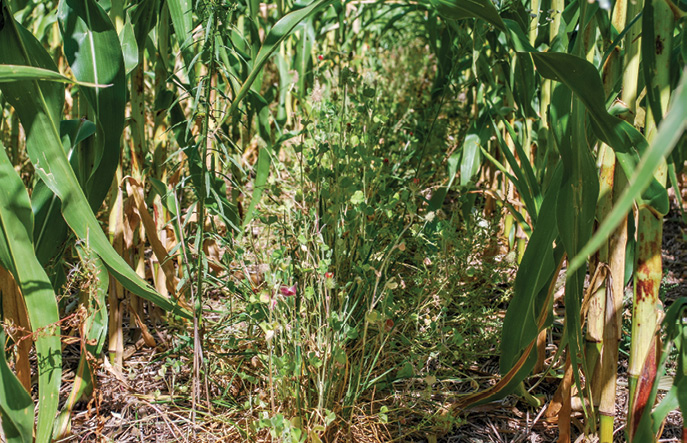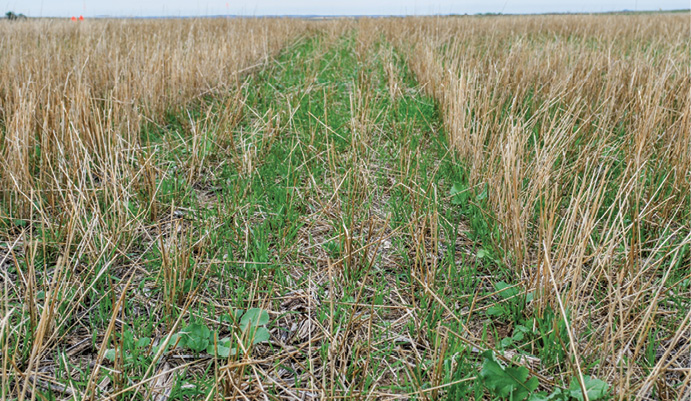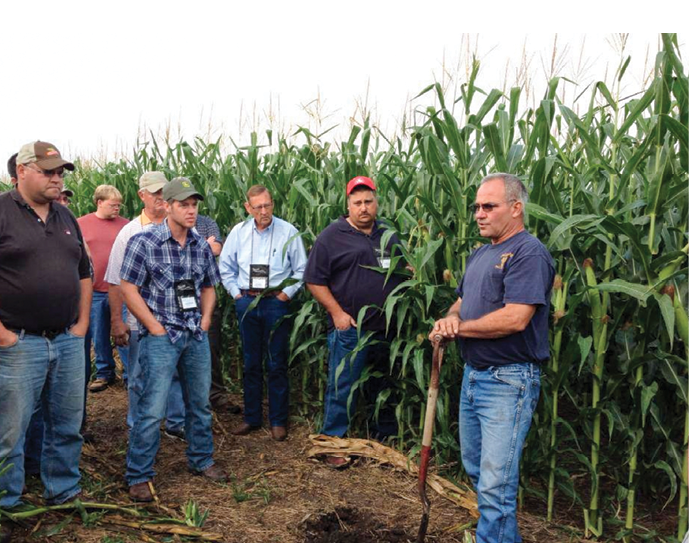When Rick Bieber adopted no-till during the 1980s, he knew little about how or why reduced tillage might benefit his soils. He was simply searching for ways to lower input and labor costs to make his farming operation a paying proposition.
“I didn’t have the money to purchase all the iron it would take to do the tillage that was considered to be essential to a successful farming operation at that time,” Bieber says. “I had to make do with the aging, small amount of equipment I could afford.”
But times have changed for Bieber, who with his son, Ben, raises wheat, corn, soybeans, flax, peas, sunflowers and alfalfa on about 5,000 acres near Trail City, S.D. They also manage 5,000 acres of rangeland, running a 600-head cow-calf operation.
Bieber has become one of South Dakota’s most passionate advocates for no-till practices, speaking at numerous conferences and field days about the importance of soil health, not just reducing expenses.
“I’m not so sure that I introduced no-till practices so much as I re-introduced them to our farm,” he says. “Many of the things we’re beginning to do now were used in farming before all our modern technology was developed.
“Over the years I’ve come to view the soil to be similar to the skin that covers our human bodies, and residue and cover crops are like clothes on the soil,” he adds. “Soil needs to be protected just like the skin on our bodies. Just as we don’t like to be poked, prodded, cut, burned or frozen in any fashion, the soil doesn’t like that either.”
The Start Of Change
Bieber grew up on his family’s wheat farm, which was established when both his maternal and paternal grandparents came to the Dakotas from Ukraine and homesteaded next to each other near Trail City.
The light soils found there have been prone to erosion for decades.
“One of my grandfathers was very conservation minded,” Bieber says. “The other approached farming with the attitude of ‘Let’s see how much we can get off the land.’ During the 1930s and ’40s, soil that was lacking conservation practices blew heavily. The effect of that is still evident in the respective productivity of our farm ground today.”
Bieber easily recalls the wheat fallow that was part of the traditional wheat-farming process his family practiced.
“In the 1970s, we tilled the heck out of everything,” Bieber says. “Our county’s average spring wheat yield was 17 bushels per acre. Our proven yield was 21 bushels per acre, so we though we were doing well.”
In the 1980s, soaring interest rates and the financial stress rippling through the farming industry pushed many U.S. farmers to the sideline, taking a toll on the Bieber family, too.
“There were a number of years when my father’s income figures fell into the red. That’s when we started taking a completely different approach to farming,” Bieber says. “For economic reasons, I started using less tillage and looked for ways to cut input costs as much as possible.”
With lowered inputs, Bieber says he began realizing annual profits, even when farming soil in desperate need of improvement. He soon took over operation of the land on his father’s farm.
“Using that same low input, low-labor-cost paradigm, our farm survived the 1980s and thrived into the ’90s,” Bieber says. “Then came the 2000s, when we saw some of the most extreme weather conditions we had ever experienced on the farm.
“In 2006 we had the lowest rainfall ever recorded in our region. In 2012 we had some of the highest temperatures ever recorded in several decades. Still, our soils continued to perform.”
Optimizing Moisture Use
Average rainfall in Bieber’s locale ranges less than 17 inches per year, in addition to some snowfall.
Over the past 27 years, Bieber has learned that the amount of rainfall received isn’t nearly as important as how efficiently rainfall is captured and used.
“It’s probably one of the biggest questions I hear,” Bieber says. “Everyone wants to know how much rainfall we receive. But the more important question is how we manage that rainfall.”

As he’s refined his no-till system, Bieber has learned that leaving residue on the soil surface, keeping a growing root in the ground throughout the growing season and leaving soil undisturbed all contribute to effective moisture capture and utilization.
“Soil scientists are now verifying what we have suspected for a while — that soil needs carbon to feed the biological ‘family’ that lives beneath the soil surface,” Bieber says. “Soil organic matter is a source of carbon, but it is also the sponge that holds moisture in the soil at the root zone, where it’s available to plants.”
Exactly what seeding rate and cocktail mix Bieber uses for covers “depends on about a million different things,” he says. “We use a uniform distribution of all the plants in the mix so that there’s the same number of each type of plant per acre.
“If you have large seeds, like sunflower, that means you may have 10 pounds of sunflowers per acre and the amount of the remaining seeds are calculated accordingly.”
Rather than seeking a specific turnip, radish or seed that might be in short supply, or may not provide the necessary soil benefit, Bieber advises farmers to build their cover-crop mix from four different plant family types: Warm-season grasses and warm-season broadleaves, cool-season grasses and cool-season broadleaves.
“That’s the natural plan found in God’s design of the Earth,” Bieber says. “Each of those types of crops serves a purpose. The farmer has to decide what his soil needs and then select the type of cover-crop mix that will satisfy those needs.”
Interseeding Success
When corn reaches the V-6 or V-7 stage, Bieber flies on a cover crop like cereal rye so the cover will sprout and grow following a rain.
“Once that corn crop matures or freezes the cover crop takes over, sequestering carbon to continue feeding the soil biota,” Bieber says. “In our area, that biologic activity will generally continue through October, November and into December.”
Behind wheat, Bieber uses a seeder to plant a cover-crop mix of warm-season broadleaf and grasses, and cool-season broadleaf and grasses, so soil biology is fed throughout the current growing season. Winter freeze terminates the crop.
Among the species in the Biebers’ cover-crop mixes are purple-top turnips, daikon radishes, lentils, peas, proso millet, German millet, flax, buckwheat and volunteer spring wheat. The’ve also used crimson clover and winter wheat.
Bieber’s farm began experimenting with covers in 1998. In 2006, South Dakota State University began establishing research plots on their farm, the driest year on record on the farm.
“That year we had limited success with the covers,” Bieber says. “But we planted them again in 2007 and 2008 and they did well.”
To maximize benefits from covers, the Biebers graze livestock on them once the ground freezes, or as long as there’s a vigorous root system to support livestock hoof action.
“In the past, it seemed that whenever livestock loitered on farmland, subsequent crop yields suffered,” Bieber says. “For us, we are at least maintaining if not increasing yield, yet still using our soils for meat production.”
Because the covers feed soil biology and soil organic matter remains intact, moisture holding capacity of the soil continues to build. “The porous characteristics of the soil also allows plant roots to ‘breathe,’ even if moisture saturates soil,” Bieber says.
“It’s not my individual ‘recipe’ that’s important to cover-crop use. It’s the principle of using the correct family of cover-crop types to fulfill the needs of a farmer’s soil.”
Optimizing Moisture Use
The Biebers evaluate their annual land-management success by evaluating the pounds of harvestable material per inch of rainwater they produce.
They believe those numbers reveal both the quality of their soils and the level of success they’ve achieved in providing soils and plants with the best possible nutrients and growing environment.
“Since 1987, our yields have tripled and the number of harvestable pounds of material we raise increases every year,” Bieber says. “Healthy soils take care of the crops.”
Organic matter levels in soils surrounding the Bieber’s farm average 2%, but on their own farmland the range is 4% and 5%.
“That’s why we see such incredible results with so little rain,” Bieber says. “Typically, soils with 2% soil organic matter hold 3 or 4 inches of water at the root zone. With 4% to 5% organic matter, my soils hold more than 6 inches of moisture.”
Fine root systems of covers also stimulate soil aggregation, or the binding of soil particles together. Taproots featured on some covers push down into subsoil, stimulating water infiltration and subsoil aeration. The living plants also help hold leachable nutrients such as nitrogen to keep it from leaching into groundwater.
“Recent research suggests that plant-root systems contribute twice as much organic material to soil during the growing season as what is found in the root system at the end of the growing season,” Bieber says.
Diverse Rotations Prosper
The Biebers use a 5-year crop rotation that includes cool-season grasses (wheat and oats), then warm-season grasses (corn, millet and forages).

From there, Bieber goes to broadleafs (sunflower, flax, peas, alfalfa) and anything else he believes will improve soils and reduce inputs for the following wheat crops. Whenever he’s been tempted to deviate from his standard crop rotation to “chase a market,” Bieber has found that yields suffer.
“We may stack crops back to back once,” Bieber says. “If we try that more than 1 year, our inputs skyrocket and yields plummet.”
The Biebers find wheat stubble helps protect soils so corn plants following wheat have what they need to withstand extreme growing conditions that can occur in their location.
“The corn root system develops during a cool point in the growing season so when the heat comes, corn plants have a fully developed root that can stand adverse conditions,” Bieber says. “If our moisture is short, we switch from corn to a crop with lower water use, like millets.”
Corn plants also aid wheat because they support soil biology.
“Warm-season grass like corn causes soil biota levels to rise,” Bieber says. “Before you grow wheat, you need to include a disease-breaking, soil biota-friendly broadleaf. That aids the wheat seed in taking on moisture and sprouting in a friendly environment.”
The Biebers started no-tilling sunflowers in 2002, feeling that a broadleaf was needed in their rotation.
“Many broadleaves don’t thrive under high temperatures and low moisture, but sunflowers will,” he notes.
Sunflower yields for the Biebers have ranged from 2,400 to 2,600 bushels per acre. In 2010, one field topped out at 3,500 bushels per acre. Sunflowers follow corn and are planted between standing corn stalks.
“We strive to leave all crop residue attached to the root,” Bieber says. “If you have long, tall residue, it’s easier to plant into.
“It’s like combing your hair. If your hair’s on your head, it’s easy to comb. If you cut it off and it’s lying on the floor, you can’t comb it. It’s typical in the no-till industry to use chopping rollers or fluted rollers to chew up crop residue. That may make the field look prettier, but there are less residue-handling issues with long, tall stalks.”
Getting More Yield
While keeping input costs low is a high priority on the Bieber farm, the Biebers do strategize to maximize yield.

“We manage intensely for high-quality, high-yield wheat,” Bieber says. “We fertilize with our drill and topdress. We’ll fertilize wheat a third time when we feel it’s necessary in order to achieve high-quality spring wheat.
“We also fertilize our sunflowers, since that’s the deepest-rooting crop in our rotation. We don’t want vegetative growth on the sunflowers, but we want to give them full advantage of nitrogen during seed fill. The tremendous oil that produces in the sunflowers nets tremendous weight at the elevator.”
Bieber says his fertilizing practices stem from past experiences 20 or 30 years ago when his father didn’t apply added nutrients and experienced significant yield loss as a result.
Because of his soil quality today, Bieber doesn’t believe the extra fertilizer is really necessary.
“Fertilizing is really something I need to wean myself from,” he says. “I’ve just struggled with making that change. When we fertilize we broadcast it. We know we don’t have a loss of the fertilizer from volatilization or leaching because active soil biology consumes nitrogen molecules and holds them.”
Bieber points out that current soil-testing practices won’t necessarily reveal the presence of nitrogen in his biologically active soil, because soil biology captures the nitrogen and holds it until the plants need it.
“Current testing identifies nitrogen that’s floating in the soil but won’t measure what soil biology has captured,” he says.
The Right Machines
When it comes to equipment, the Biebers look for features that fit the requirements of their no-till system.
“It won’t matter what color that equipment is,” Bieber says. “In a no-till system, you need a low-disturbance planter or drill, and a sprayer that covers your acres in a comfortable fashion that’s friendly to your soil.”
On their planter, the Biebers adjust down pressure in relation to the mellowness of longtime no-tilled soils in order to avoid sidewall compaction.
“For us, coulters are a function of tillage,” Bieber says. “They wiggle the ground and disturb the ‘houses’ of the soil biota, which reduces soil health. In healthy soil, the seed trench should almost close itself. If someone’s having trouble closing the trench, it’s usually a soil-health issue.”
Stripper headers are another key tool for the Bieber farm, as they strip wheat kernels out of heads while leaving straw standing upright.
This allows operators to run combines at higher speeds and in tougher conditions than when using straight-cut headers that put all the straw through the combine. They also benefit from the standing crop residue.
“The stripper headers eliminate the issue of uniform residue distribution,” Bieber says. “It also seems more efficient to leave the residue standing rather than bringing it all through the combine and then trying to evenly redistribute it.”
Proof In Numbers
Because the Biebers are often pleasantly surprised by the results of their no-till and cover-crop practices, they’ve cooperated with South Dakota State University researchers to validate soil quality and crop yields.
In 2011, after 21 years of continuous no-till on the Bieber farm, a study was started to measure the effect of cover crops with and without added nitrogen, phosphorus and potassium on corn yields. Data showed a combination of cover crops and macronutrients resulted in the greatest corn yields.
“We evaluated the yields in terms of how many bushels were raised per inch of water,” Bieber says. “In our field with no cover and no added nutrients, we harvested 89 bushels per acre, or 6.36 bushels per inch of rain. In our field with covers but no added nutrients, we harvested 7.29 bushels per inch of rain, a total of 102 bushels an acre.”
In the field where both covers and nutrients were used, researchers harvested 177 bushels per acre, totaling 12.64 bushels per inch of rain.
Because moisture loss is often a concern surrounding cover crop use, the Biebers cooperated in a South Dakota State University study measuring stored soil moisture loss in test plots where covers were planted.
“In the plot where covers were planted in fall 2010, stored soil moisture in spring 2011 was 2.53 inches,” Bieber says. “In the plot with no cover, stored moisture that same spring was 3 inches. For all the benefits the covers provide, their use of .47 inches of moisture seems a good tradeoff.”
Researchers who evaluated the cost per bushel of corn for the farm’s 2011 harvest found that an average of 122.5 bushels per acre of corn was raised in fields where cover crops were planted. That same year, in fields without cover crops, corn yields averaged 108 bushels per acre.
“That year, the total cost of raising the corn in fields with the covers (including land cost) was $2.39 per bushel,” Bieber says. “The cost in the areas without covers was $2.71 per bushel.”
Fall Cover Crops Shine
In a 3-year test plot study conducted on the Bieber’s farm by South Dakota State University researcher Cheryl Reese, data was gathered between 2010 and 2012 to gauge the impact of cover crops on soil quality, corn yield and soil nitrogen.
In this study, done jointly with the USDA’s Natural Resources Conservation Service, cover crops were planted into the plot’s wheat stubble in August 2010. Control plots were established at the same time to contrast the effect of no cover crop being seeded.
In spring 2011, Bieber planted corn into the test-plot area. A third cover crop treatment was added in June of 2011 as a cover crop was drilled into growing corn.
In Spring 2012, Bieber planted sunflowers across Reese’s cover-crop plots, and the following fall Reese sampled sunflowers from the plots seeded in August 2010, those seeded in June 2011 and those plots that didn’t have cover crops.
In that single-year, single-site comparison, sunflower yield was shown to be greater in plots where cover crops were planted in August 2010 as compared to the other two plots.
“From that study, Reese concluded that the fall cover crop provided the most yield benefit,” Bieber says.
While more study of the benefits of in-season and fall cover crops is required, Reese theorized that the living roots provided by fall-sown covers might be assisting in “maintaining a healthy population of soil biota.”







Post a comment
Report Abusive Comment